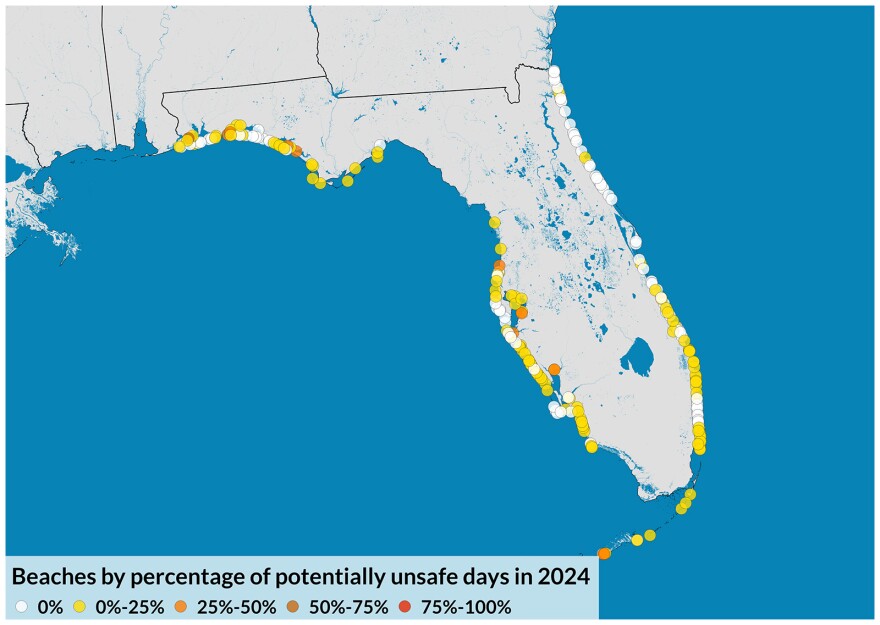Palma Sola South in Manatee County was one of Florida’s most unsafe beaches for swimming in 2024 — and scientists say they still don’t know exactly why.
The Environment Florida Research & Policy Center said 58% of Florida beaches tested last year had at least one day where bacteria levels exceeded the Environmental Protection Agency’s safety marker, known as the Beach Action Value.
Palma Sola South had 20 potentially unsafe test dates last year, the second most of any beach in the state.
A new research effort led by the Sarasota Bay Estuary Program hopes to uncover what’s behind the contamination.
Director David Tomasko said the state’s indicators — enterococci, E. coli, and fecal coliforms — are useful but vague.
He said the problem is none of the three are specific to humans or animals as a source.
“Our indicators are not necessarily indicating the source, and if the bacteria are not coming from humans, then it's less problematic,” Tomasko said. “If they're not coming from animals at all, it's even less problematic. So that's the reason why this study makes sense, and it frankly makes sense to do this in more locations.”

To find the true culprit, Tomasko’s team is deploying DNA-based tracking methods across four locations five times this summer — including areas of Palma Sola Bay where horseback riding and swimming regularly occur.
But Tomasko noted that just because a source is detected — like horses — doesn’t mean it’s the primary cause.
“The area that we're particularly focusing on has been a place where people have been horse riding for a long time, and I know some people might say, 'Why would you have horses in the bay?' ” Tomasko said.
“Well, we have boats in the bay. We have people stomping around and doing damage to the bay all the time. The bay as a whole is healthy, and the horses, if they're not a bacteria source, they're not a real big problem.”
Tomasko also pointed out that stopping the horseback riding popular in the area without cause could damage private businesses.
“We don't want to get rid of the horses as a business if there's no reason why to get rid of them, because they're not really that big of a source. ”
He added that the study will help Bradenton decide how to balance environmental protection with community activities.
“They [the horses] take kids out who have special needs. They take out wounded veterans. You know, they do a lot of good things, like horseback riding therapy,” Tomasko said.
”If they're not a big source of the problem, then the city of Bradenton and the Estuary Program are like, then 'What's the big deal?' ”
Tomasko’s background shapes how he views the issue. He’s worked on pollution studies in the Philippines, Saudi Arabia, Oman, Abu Dhabi, Korea and across the Caribbean.
He described fieldwork in Manila, where his former professor once got such a severe ear infection from polluted water that he couldn’t fly home.
In contrast, Palma Sola Bay is relatively healthy with a recent 40-acre increase in seagrass coverage. All the same, Tomasko admits it may not look all that appealing.
“It's not crystal clear blue water. It's always got this kind of yellowish, reddish, brownish tint to it, but mostly that's tannins. That is the same thing that makes your iced tea look the color it does. This is just from mangrove fringes,” Tomasko said.
”It's got a lot of manatees that hang out there. It's got a lot of dolphins that hang out there; it's kind of a dolphin nursery,” he added. “It's an area that, because it's kind of tucked away and it's kind of hard to get to.”
Tomasko said that his global experience has shown him what works and what doesn’t. A contaminated water case in Miami reminded him of this.
“It was just breeding bacteria, but it wasn't from fecal material. It was from decomposing fruit,” Tomasko said. “What we found in that study was maybe only about 2% of the bacteria were from humans. The rest of it seemed to be from decomposing vegetation, in this case, fruit.”
He sees parallels between those situations and Palma Sola — a case where data-driven decisions are crucial before taking action.
He also emphasized the importance of recognizing environmental success stories, like the cleaner waters of New York, Paris and London, while staying vigilant about the threats of climate change and extreme weather in Florida.
“We just need to do more,” Tomasko said. “It's not always bacteria. Sometimes it's algal blooms, red tide, things like that. But you know, if we can't fix the problems related to algal blooms and bacteria, how in the hell are we going to handle climate change?”




